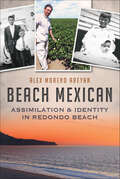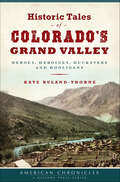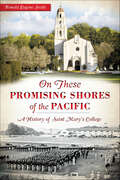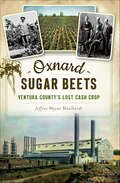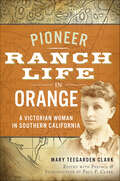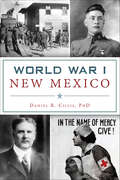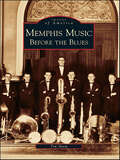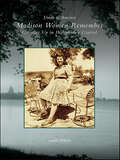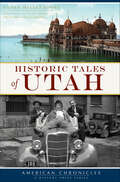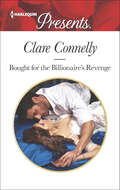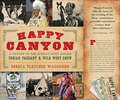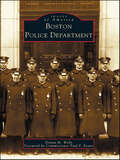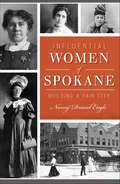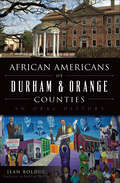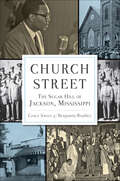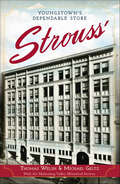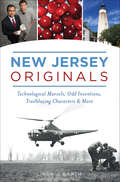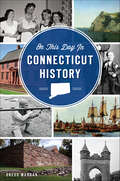- Table View
- List View
Coal Mine Disasters of North Carolina (Disaster)
by John HairrDuring the past two centuries, the central region of the Tar Heel State was populated with numerous active coal mines, many of which dealt with catastrophes such as cave-ins or gas explosions. Over fifty-three miners lost their lives in an explosion at the Carolina Mine at Coal Glen in 1925, the largest industrial disaster in state history. The Egypt Coal Mine was a key resource for Confederate forces during the Civil War despite a series of explosions that claimed scores of lives. The last efforts by the Raleigh Mining Company to continue coal mining in the state in the 1950s were marred by accidents and signaled an eventual end to the industry. Author John Hairr chronicles the history and tragedy of coal mining in North Carolina's Deep River region.
Beach Mexican: Assimilation & Identity in Redondo Beach (American Heritage)
by Alex Moreno AreyanAlex Moreno Areyan's odyssey of growing up Latino in white upper-middle-class Redondo Beach in the 1950s presents a story of assimilation different from that experienced by Mexican Americans in larger barrios. His annual "white lie" to classmates was that his father got a job up north and the family was moving. They moved, all right--in a 1941 Plymouth with the harvest. In Marysville, Meridian and Mendota, they lived in tents and cars, under trucks and in corrugated tin hovels while picking cotton, tomatoes, peaches, walnuts and plums. The kid once threatened with permanent expulsion from Redondo Union High for speaking Spanish on campus eventually received a plaque from the City of Redondo Beach for writing the Mexican American history of the city. "Beach Mexican" proves the journey wasn't easy.
Historic Tales of Colorado’s Grand Valley: Heroes, Heroines, Hucksters and Hooligans (American Chronicles)
by Kate Ruland-ThorneColorado's Grand Valley has an extensive geological and human history going back millennia. Franciscan priests worked in tandem with the native Ute people to plot passage through the territory, opening the valley to unprecedented settlement. The region became the playground of enterprising visionaries, murderous outlaws, hooligans and harlots alike. From the gruesome Meeker massacre and its tragic consequences for the Ute nation to the mysterious murder of Sam McMullin and a showdown with the Ku Klux Klan in 1925, uncover the engrossing stories of an unyielding land. Author Kate Ruland-Thorne recounts many of the defining and damning moments throughout Grand Valley history.
On these Promising Shores of the Pacific: A History of Saint Mary's College (Landmarks)
by Ronald Eugene IsettiThe original fog-soaked Saint Mary's College campus in San Francisco enrolled both boys and young men and was born in 1863 from the educational vision of Archbishop Joseph Sadoc Alemany. In 1889, the campus moved to Oakland and was affectionately dubbed the "Old Brickpile." Through fires, earthquakes, two world wars and bankruptcy, the college persevered and matured, eventually moving to its present location in Moraga Valley. From United States Navy cadets and "Slip" Madigan's Galloping Gaels to the Latin Question and iconic phone booth stuffing, historian and retired Saint Mary's College professor Ronald Eugene Isetti offers a detailed look at the college's legacy. Join Isetti as he chronicles the academic vision, institutional challenges and student traditions of one of California's oldest establishments of higher learning.
Oxnard Sugar Beets: Ventura County's Lost Cash Crop (Lost)
by Jeffrey Wayne MaulhardtIn the early 1890s, farmers Albert Maulhardt and John Edward Borchard discovered Ventura County's favorable conditions for a highly profitable new cash crop: the sugar beet. Not long after inviting sugar mogul Henry T. Oxnard to the area, construction began on a $2 million sugar factory capable of processing two thousand tons of beets daily. The facility brought jobs, wealth and the Southern Pacific rail line. It became one of the country's largest producers of sugar, and just like that, a town was born. Despite the industry's demise, the city of Oxnard still owes its name to the man who delivered prosperity. A fifth-generation descendant, local author and historian Jeffrey Wayne Maulhardt details the rise and fall of a powerful enterprise and the entrepreneurial laborers who helped create a city.
Pioneer Ranch Life in Orange: A Victorian Woman in Southern California
by Mary Teegarden ClarkThis previously unpublished account of early California ranch life from 1875 to 1887 covers a pivotal era in Orange County history. Vassar-educated Mary Teegarden Clark captured the future Orange County during its transition from the untamed cattle rancho era to citrus empire. Mary writes engagingly about breaking ground for the citrus Yale Grove in the city of Orange, her home life with husband Albert B. Clark and workaday ranch chores with Chinese and Latino farmhands. Her firsthand accounts enlarge the historical record of citrus marketing, wilderness excursions and the escapades of Wild West pistoleros. Through deft editing, Paul F. Clark, Mary's great-grandson, provides the historical framework through which to view Mary's remarkably vivid experiences.
Emerald Fire
by Sandra MartonMost women found Slade McClintoch irresistibly attractive, with his dark charisma and hardmuscled physique. But Brionny Stuart vowed she wasn’t one of them. If anything, she had always been turned off by Slade’s arrogant sort! So why couldn’t she forget how skillfully Slade had tried to seduce her? She must concentrate on taking the Eye, an ancient, legendary, Inca emerald, back from Peru to New York!However, her expedition went tragically wrong, and suddenly Brionny, the cool, city girl, was at the mercy of the steaming jungle...and Slade. Would he help her back to civilization, or tempt her into making fierce, primitive love...?
World War I New Mexico (Military)
by R. Cillis PhDIn 1917, five years after New Mexico received its statehood, the United States entered World War I. With border tensions festering between Mexico and the United States, Germany attempted unsuccessfully to secure Mexico's allegiance with its Zimmermann Telegram. More than sixteen thousand New Mexicans joined the military, while civilians supported from the home front. Groups like the Knights of Columbus, YMCA and the Salvation Army, as well as Governor W.E. Lindsey's New Mexico Council of Defense, raised military funding. Author Daniel R. Cillis recounts the Land of Enchantment's influence on World War I from its beginning through to the 1918 Armistice.
Memphis Music: Before the Blues
by Tim SharpMemphis means music. That relationship was solidified in 1909 when W. C. Handy wrote the song �Mr. Crump� and later published it as the �Memphis Blues.� As Handy�s songs were sung and played in streets and music halls, a spotlight began to shine on a new mecca for innovation in music�Memphis, Tennessee. Memphis Music: Before the Blues surveys the people, music, and events that contributed to the rich musical life that emerged against the backdrop of the Civil War and yellow fever in the 19th century. The story is not just one of the building blocks to what has been called America�s greatest export�popular music�but rather it is a story of ongoing innovation and creativity that came from a convergence of people of different cultures.
Madison Women Remember: Growing Up in Wisconsin's Capital (Voices of America)
by Sarah WhiteMadison is Wisconsin�s capital city and the �land of the four lakes.� Since the city�s founding 150 years ago, rich and poor have lived in close proximity surrounded by the beautiful lakes, a fact that has played a role in the city�s aspirations toward social justice and a good quality of life for all its residents. Celebrate Madison�s 150th birthday as women born between 1915 and 1957 reminisce about growing up here. Meet their families and friends, enjoy their pastimes, and ultimately follow them through their experience of an adventure everyone shares�coming of age at a particular place and time, receiving its stamp on one�s character, values, and ambitions. These moving, entertaining first-person accounts gleaned from oral history interviews with women from a wide range of backgrounds reveal the changing nature of Madison over time.
Historic Tales of Utah (American Chronicles)
by Eileen Hallet StoneFrom the rugged beauty and refined splendor of this vast state emerges a remarkable volume of personal recollections, narrative histories and astonishing stories. Explore the fortitude and cultural diversity behind the development of Utah through "Big Bill" Haywood, vilified by the New York Times as "the most feared figure in America." Experience compelling accounts of women bruised on the front lines of suffrage battles, enthralling stories of Chinese "paper sons and daughters" and heroic endeavors of Northern Ute firefighters. Celebrate downtown's "Wall Street of the West," the off-road cyclist known as the "Bedouin of the Desert" and Utah's love affair with sweets. Culled from her popular Salt Lake Tribune "Living History" column, award-winning author Eileen Hallet Stone uncovers captivating tales of ordinary people and their extraordinary contributions that shaped Utah history.
Bought for the Billionaire's Revenge
by Clare ConnellyLong-lost lovers reunite in this powerful marriage of convenience and second chance romance.Their connection was irresistible, but she was forced to walk away. Now the billionaire is back, and he has a proposal for her . . . Innocent socialite Marnie Kenington was devastated when her parents forced her to spurn Nikos Kyriazis. She’s never forgotten him, nor his raw sensuality. So, years later, when Nikos insists on a meeting, Marnie’s heart leaps. . . . Seeing him again, it’s clear the chemistry between them has never stopped burning. But when Nikos offers to save Marnie’s family from bankruptcy if she agrees to marry him, Marnie is torn—saying “yes” is a risk to her heart, but with her family at stake, how can she refuse?Marnie’s rejection drove self-made billionaire Nikos to unimaginable success. Now, by meeting her at the altar, he can finally show her what she’s been missing out on all these years! Marnie’s poise is legendary, but he knows in the bedroom, their passion will unravel her completely! But he doesn’t bargain on their wedding night being the start of his own undoing . . .
Happy Canyon: A History of the World's Most Unique Indian Pageant & Wild West Show (American Heritage)
by Rebeca Fletcher WaggonerFor over a century, the Happy Canyon show has brought together families, friends and strangers to witness a joyous celebration of local history. Originally staged in 1914 by Roy Raley, the all-volunteer show presents a live retelling of Pendleton's founding that honors both the beauty of tribal life and the spirit of the Old West. Today, the show is truly a family affair, and many performers and organizers are descendants of those early actors and crew. Author Becky Fletcher Waggoner delivers a detailed, loving view of the show's history, illustrated with beautiful photography and fascinating archival photos that join past and present.
Richard Sopris in Early Denver: Captain, Mayor & Colorado Fifty-Niner
by Linda BjorklundFrom Gregory's Diggings prospector to Denver mayor, Richard Sopris left an indelible mark on the Mile High City and Centennial State. During an 1860 prospecting expedition, Sopris discovered Glenwood Springs and the nearly thirteen-thousand-foot summit later named for him. Following life as a steamboat captain, he was appointed captain of Company C, First Colorado Cavalry, in 1861 and commanded volunteer troops at Glorieta Pass. After serving as a delegate to the first constitutional convention of Colorado and as Arapaho County sheriff, he helped quell the Hop Alley Chinese Riot of 1880 and enacted public works projects to rid Denver of a deadly typhoid outbreak. After his mayoral term ended in 1881, Sopris became the first commissioner of his beloved City Park. Author Linda Bjorklund celebrates the unsung life and accomplishments of a founding son of Colorado.
Boston Police Department (Images of America)
by Donna M. WellsThe Boston Police Department was formally organized in 1854, but the department traces its origins to the establishment of a night watch of six men and an officer in 1631. At a town meeting in 1701, watchmen were instructed to be "on duty from ten o'clock till broad daylight. . . . They are to go about silently with watch bills, not using any bell, and no watchman to smoke tobacco while walking their rounds; and when they see occasion, to call to persons to take care of their light." Today, the duties of the Boston police officer are supported by advanced forensic technologies and modern equipment. Officers walk neighborhood beats, control local crime, and are ready at a moment's notice to respond to acts of terrorism. Boston Police Department, the first comprehensive photographic history of the department, details one hundred fifty years of crime fighting in Boston. The collection includes images of the 1919 Boston Police Strike; an overview of specialized units, vehicles, uniforms, and equipment; and an honor roll of officers who have fallen in the line of duty.
Influential Women of Spokane: Building a Fair City (American Heritage)
by Nancy Driscol EngleWhile known as the home of Father's Day, Spokane benefited from its share of trailblazing women. In 1886, Mother Joseph, a pioneering architect, constructed the first Sacred Heart Hospital. After fire destroyed thirty-six blocks in 1889, Anna Stratton Browne and her friends raised $10,000 to build a home for needy children that operated for six decades. And in early 1908, May Hutton became president of the Spokane Equal Suffrage League, persevering until 1910, when Washington voters gave women the vote. Historian Nancy Driscol Engle commemorates the unforgettable contributions of Spokane's women.
The Bronx
by Gary Hermalyn Kathleen A. McAuleyWith a population of more than one million and covering over 42 square miles, the Bronx is a vibrant part of New York. The Bronx was given its name in 1898 when the new borough was named after its single largest geographical feature: the Bronx River. The Bronx showcases the borough's rich history in a personal way through vintage and contemporary images. Kathleen A. McAuley is the director of museums and curator for the Bronx County Historical Society. Gary Hermalyn, coauthor of Yankee Stadium: 1923-2008, is the CEO of the Bronx County Historical Society.
Adirondack Reflections: On Life and Living in the Mountains and the Valleys
by Neal Burdick and Maurice KennyThe Adirondacks have been written about since they were first spied by Europeans more than five hundred years ago. Yet for most of the intervening centuries, few of those writers lived in the region of which they wrote--they were not part of the landscape. That has changed in recent years as writers have moved to the Adirondacks and formed a literary community. Perhaps inspired by these writers, longtime residents have discovered that they, too, could be part of such a community. From scratching out a living in the harsh landscape to the wonders of a moonlit cross-country ski, these writers celebrate life in the Adirondacks. In this remarkable collection of essays, the experiences of Adirondack natives are interwoven with the land in a part of America that is both demanding and rewarding.
African Americans of Durham & Orange Counties: An Oral History (American Heritage)
by Jean BolducDurham and Orange Counties have vibrant and active African American communities. Throughout the region's unjust past, generations have shown extraordinary strength and resolve. Floyd McKissick became the first African American student at the University of North Carolina School of Law after Thurgood Marshall argued for his admittance in court. The struggle for civil rights in Durham shaped the poetry of Jaki Shelton Green, one of the state's most esteemed wordsmiths. More recently, local leaders such as Michelle Johnson find the work of equality is far from over. Journalist and writer Jean Bolduc reveals the voices of Durham and Orange County African Americans in a series of inspirational oral histories.
Church Street: The Sugar Hill of Jackson, Mississippi (American Heritage)
by Benjamin Bradley Grace SweetThe 1930s and 1940s saw unprecedented prosperity for the African Americans of Jackson's Church Street. From the first black millionaire in the United States to defenders of civil rights, nearly all of Jackson's black professionals lived on Church Street. It was one of the most popular places to see and be seen, whether that meant spotting Louis Armstrong strolling out of the Crystal Palace Club or Martin Luther King Jr. organizing an NAACP meeting at his field office on nearby Farish Street. Join authors and veterans of Church Street Grace Sweet and Benjamin Bradley as they explore the astounding history and legacy of Church Street.
Pizitz: Your Store
by Tim HollisFor nearly ninety years, Pizitz offered Birmingham residents and Alabamans across the state a one-of-a-kind shopping experience. From the Enchanted Forest that sprung up every Christmas to in-store fashion shows, visiting Pizitz wasn't just a trip to the store, it was an event. Yet Pizitz was more than just a department store--it was a Birmingham institution. When Louis Pizitz opened up his first dry goods store in downtown Birmingham in 1899, he began a career as a successful businessman and a generous philanthropist, establishing a tradition of giving freely to local causes that has come to define the Pizitz family. Join Birmingham historian Tim Hollis as he recounts the fascinating history behind one of Alabama's most recognizable names and treasured retailers.
Strouss': Youngstown's Dependable Store (Landmarks)
by Mahoning Valley Historical Society Thomas Welsh Michael GeltzMore than two decades have passed since Youngstown lost its beloved Strouss' Department Store. But Youngstowners can still taste those incomparable chocolate malts, see the dramatic view from the store's mezzanine and feel the excitement of the annual Thanksgiving Day parade. The story of Strouss' kept pace with the powerful trends that defined Youngstown as a whole. This was especially true during the boom years of the early twentieth century, when the store was the shopping hub in a community known as "America's Ruhr Valley." But the city changed, and Strouss' changed with it. In this unprecedented historical narrative, Welsh and Geltz dig deep into Strouss' past to uncover a dramatic story that will surprise--and delight--Youngstowners of all ages.
New Jersey Originals: Technological Marvels, Odd Inventions, Trailblazing Characters and More
by Linda J. BarthNew Jersey's institutional research accolades are renowned--medical inventions at Johnson & Johnson, the genius of Edison Labs and fourteen Nobel Prizes to Bell Labs scientists.But beyond those behemoths of innovation lie many more breakthroughs and firsts. In 1869, Rutgers and Princeton played the first college football game. Famed inventor Abram Spanel developed the Apollo space suit at his home, Drumthwacket, now the official residence of governors. The American Can Company and Krueger Brewing Company teamed up to create the first beer can. Author Linda J. Barth reveals these and many more stories of the state's diverse tradition of original ideas and trailblazing personas.
Pittsburgh’s Greatest Teams (Sports)
by David FinoliPittsburgh is synonymous with winning. From the Penguins and Steelers to the Pirates and Panthers, the Steel City knows championships.There must be something special in the water to make Pittsburgh so particularly gifted with its sports teams. The most famous teams in the city's history would most likely be the 1970s Steelers, known as the Steel Curtain for obvious reasons, and the Penguins who raised the Stanley Cup five times. Names such as Lemieux, Crosby, Roethlisberger, Bradshaw, Clemente and Stargell are legends of American sport and members of Pittsburgh's most cherished franchises, but for every sports legend and multi-million dollar franchise, there are a dozen more talented players and long-past teams that have been forgotten to history; the Negro League's Crawford and Homestead Grays are too often overlooked in the city's sports history but were as talented as any team that has played there. Author Dave Finoli ranks the fifty greatest teams that won trophies, brought glory and lifted the hearts of Pittsburgh's devoted sports fans.
On This Day in Connecticut History
by Gregg ManganConnecticut's character runs much deeper than breathtaking fall foliage and quaint coastal towns. One day at a time, author Gregg Mangan chronicles fascinating episodes in state history, from the earliest European settlements to the modern era. After a lengthy debate, the state senate voted in favor of "Yankee Doodle" as the official state song on March 16, 1978. Bridgeport's General Electric Company completed work on the bazooka on June 14, 1942. On the morning of December 4, 1891, the only four-train collision in American history occurred at the railroad station in East Thompson. Each date on the calendar holds a nugget of knowledge in this celebration of Constitution State history.

